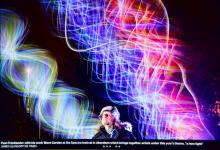Paul Friedlander is a light artist known for his innovative use of movement and light in his artwork. Born in 1951 in Manchester, UK, Friedlander was drawn to art and science from a young age, inspired by the space age and influenced by his parents' backgrounds in mathematics and art. His father, F. Gerard Friedlander, was a mathematician at the University of Cambridge and a fellow of the Royal Society, while his mother, Yolande Friedlander, was an abstract artist.
Friedlander's early fascination with building and mechanics was evident from his childhood. He recalls constructing mechanisms from odds and ends, displaying an early inclination towards constructivism. This inclination was further fueled by his mother's encouragement and exposure to contemporary and abstract art.
He pursued physics at the University of Sussex, where his tutor was Sir Anthony Leggett, who later won a Nobel Prize. His interest in art was reignited during his university years, particularly after visiting kinetic art exhibitions in London. This led him to combine his scientific knowledge with artistic expression, culminating in his invention of chromastrobic light - a light that changes color faster than the eye can perceive - in 1983.
Friedlander's career took a diverse path. Initially involved in stage lighting, including for avant-garde music, he eventually decided to focus entirely on art. His artworks, which often involve large-scale kinetic light sculptures, are influenced by chaos theory, string theory, and cosmology. One of his most significant works, "Timeless Universe" (2006), was inspired by the theory that time does not exist.
His art has been featured in numerous exhibitions and festivals worldwide, including a memorable installation at the Jerusalem Light Festival in 2009. He has received several awards and honors, such as the USHIO America Award for Innovation and prizes at ARTEC, Japan's leading hi-tech art show.
Friedlander's work is marked by a persistent exploration of scientific and artistic boundaries. He has delved into topics like cosmology and quantum mechanics, even applying these concepts to understand consciousness and the mind. His art, a unique blend of light, movement, and scientific principles, continues to be celebrated and exhibited globally.



